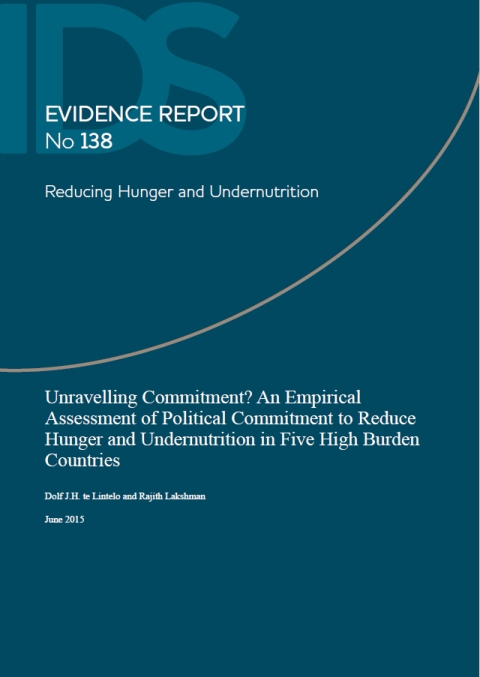Resource Center
Welcome to the UNSCN resource centre. Browse the resource centre by entering a topic or a keyword.
Unravelling Commitment? An Empirical Assessment of Political Commitment to Reduce Hunger and Undernutrition in Five High Burden Countries

The IDS Evidence Report 138, written by te Lintelo and Lakshman, has used secondary data to demonstrate that developing countries often have divergent strengths of commitment to hunger reduction and to nutrition (te Lintelo et al. 2013, 2014a). They have reviewed the literature to synthesise a set of nine political commitment indicators; construct a survey instrument; and collect primary data in five high burden countries (Bangladesh, Malawi, Nepal, Tanzania and Zambia) to ascertain whether government commitment to hunger is the same as commitment to nutrition.
In recent years, the global hunger and nutrition community has increasingly come to view political commitment as an essential ingredient for pushing food and nutrition security higher up public policy agendas (Foresight Project 2011; te Lintelo et al. 2011, 2014b; FAO, IFAD and WFP 2013, 2014; Gillespie et al. 2013; International Food Policy Research Institute (IFPRI) 2014).
In response, commitment metrics and scorecard tools to assess levels of political commitment have proliferated. They enhance accountability of governments, donors, civil society and private sector organisations for actions addressing hunger and nutrition. International organisations and aid donors also use these tools to make decisions on funding and programmatic action. Examples of these metrics include the World Health Organization's (WHO) nutrition landscape analyses (Engesveen et al. 2009); the HungerFree scorecard (ActionAid 2009, 2010); the Hunger Reduction Commitment Index (te Lintelo et al. 2011, 2014b); the Nutrition Barometer (Save the Children and World Vision International 2012); the Hunger And Nutrition Commitment Index (te Lintelo et al. 2013, 2014a); the Political Commitment Rapid Assessment Tool (Fox et al. 2014) and the Global Nutrition Report's review of Nutrition 4 Growth Summit commitments (IFPRI 2014).
These metrics have focused on operationalising the concept of political commitment to enable its measurement. Yet many inadvertently conflate commitment to address food security with commitment to tackle nutrition security; and commitment to fight hunger with commitment to combat undernutrition. This conflation is also common in the policy and academic literature (World Bank 2006) and in dominant narratives on nutrition in development (Nisbett et al. 2014). Because the concepts of food security and nutrition security are only partially overlapping, we hypothesise that government commitment to hunger reduction is empirically different from government commitment to reducing undernutrition.
The IDS Evidence Report 138, written by te Lintelo and Lakshman, has used secondary data to demonstrate that developing countries often have divergent strengths of commitment to hunger reduction and to nutrition (te Lintelo et al. 2013, 2014a). They have reviewed the literature to synthesise a set of nine political commitment indicators; construct a survey instrument; and collect primary data in five high burden countries (Bangladesh, Malawi, Nepal, Tanzania and Zambia) to ascertain whether government commitment to hunger is the same as commitment to nutrition.
View the report here.
